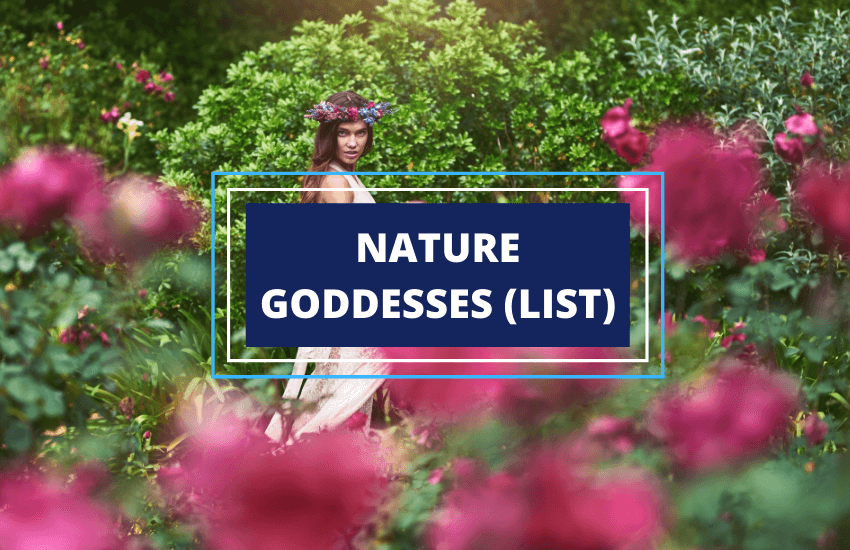
Table of Contents
In mythologies around the world, nature deities typically refer to gods and goddesses associated with some aspects or forces of nature. These types of goddesses are usually called the Mother Goddesses or Mother Nature. Generally, they’re closely linked to different natural phenomena and objects, such as seasons, rivers, harvests, animals, forests, mountains, and the Earth itself.
In this article, we’ll take a closer look at some of the key nature goddesses from different cultures and mythologies worldwide.
1- Abnoba
Abnoba, also known as Avnova, Dianae Abnobae, or Dea Abnoba, is a Celtic goddess of nature, mountains, and hunt. Her most prominent symbol is the Black Forest, the massive mountain range in Baden-Würtemburg, Germany. According to Celtic mythology, the goddess was the personification of the Black Forest, and Abnoba Mountain, located within this mountain range, is dedicated to her.
Besides mountains, the goddess was also represented by rivers and forests. She was revered as an important deity in the Black Forest area, with a number of shrines and temples built in her honor atop of the mountain and along the riverbanks. But her influence wasn’t limited to Germany. Throughout England, many rivers were called Avon as a sign of respect for the goddess.
Abnoba was revered as the patroness and protector of springs, rivers, woods, wild animals, as well as childbirth. When translated from the Celtic language, her name means She of River Wetness.
2- Aja
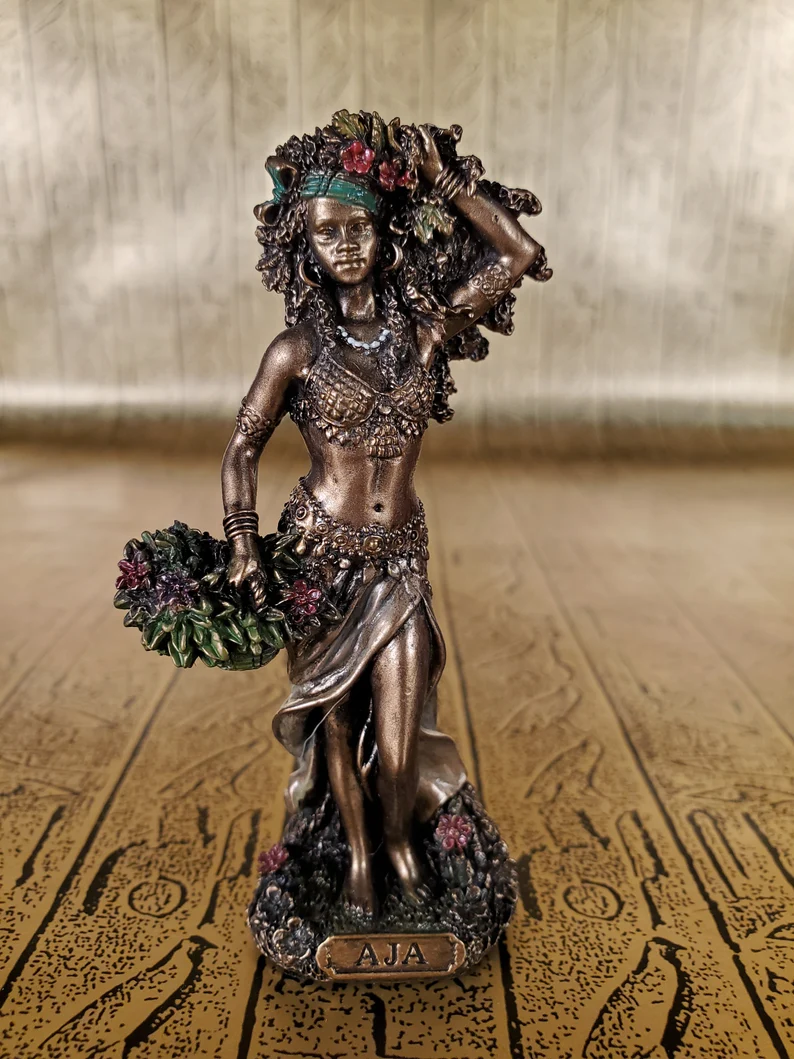
In Yoruba religion, Aja is a nature goddess, or an Orisha – the spirit associated with forests, animals, and medicinal plants. It was believed Aja had a close connection to African herbal healers and that she was the one who taught them their skills and healing art. In the New World Yoruban religion and throughout Nigeria, she’s referred to as the healer and the wise woman, ensuring her followers’ spiritual and physical health.
The Yoruba people also call her The Wild Wind. They believe it’s Aja, or the wind, who takes someone away and then returns them. They then become a powerful Babalawo or jujuman. In the Yoruba language, Babalawo means the master or the father of mysticism. Supposedly, the person who’s carried away goes to Orun, or the land of the dead or heaven, and the journey usually lasts between one week to three months.
3- Antheia
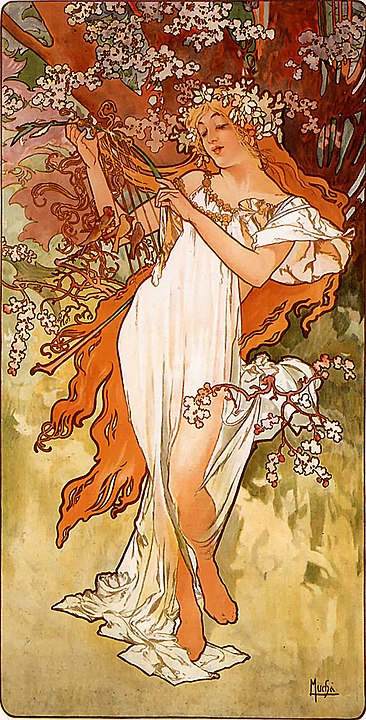
In Greek mythology, Antheia was one of the Graces, or the Charites, most commonly associated with flowers, gardens, blossom, vegetation, as well as love. Her image was usually incorporated in the Athenian vase paintings, where the goddess was depicted as one of Aphrodite’s servants.
As the goddess of vegetation, she was particularly worshiped during spring and near marshlands and lowlands, and other suitable places for vegetation growth. Her cult had a center on the island of Crete. She also had a temple dedicated to her at Argos, where she was worshiped as Hera.
4- Aranyani
In the Hindu pantheon, Aranyani is the nature goddess, associated with forests, woods, and animals that live within them. In Sanskrit, Aranya means forest. As the most prominent expression of Earth’s productivity and fertility, the goddess was considered the mother of all forests, therefore, symbolizing life and fertility. She’s also considered the patroness of forests and animals.
Aranyani is usually depicted as a young woman, full of charm and vitality. She usually wears white clothes embellished with roses, and has bells attached to her anklets, making sounds whenever she moves.
5- Arduinna
Arduinna is a Gaulish woodland goddess associated with wild nature, mountains, rivers, forests, and hunting. Her name stems from the Gaulish word arduo, which means height. She was both the hunter of the forest as well as the protector of their flora and fauna.
Arduinna was usually depicted as a young woman surrounded by nature, riding a boar and holding a spear in her hand. Throughout Gaul, the wild boar was a vital food source for the entire population, representing abundance as well as power and strength. Unfortunately, the only surviving depiction of the goddess is a small statue of a young woman riding a wild boar. As the statue has lost its head, some scholars believe it’s not the representation of the goddess after all.
Arduinna was widely worshiped throughout the regions of the Ardennes, the forested terrain stretching over the parts of today’s Germany, Luxembourg, Belgium, and France. The Forest of Arden, located in England, is also associated with her.
6- Artemis
Among the many ancient Greek deities, Artemis was probably one of the most prominent and venerated. Also known as Artemis of the Wildland and Mistress of Animals, she was the Hellenic goddess of the wilderness, wild animals, and hunting. She was also considered the patroness of young girls and women, chastity, and childbirth.
According to Greek mythology, Artemis was Leto and Zeus‘ daughter and had a twin brother Apollo. When she was three years of age, she asked her father to give her many gifts, including eternal virginity, a pack of hunting dogs, and a bow and arrow. Because of these gifts, she was often depicted carrying a bow and worshiped as the goddess of wildlife, animals, and nature. As the goddess of fertility and womanhood, Artemis was a patroness of young brides-to-be, who would give her their toys as an offering and a sign of their transitioning into full adulthood.
Artemis was also worshiped as a fertility goddess across ancient Greece, and had a temple dedicated to her at Ephesus. In the ancient world, the Temple of Artemis was one of the Seven World Wonders.
7- Ceres
In ancient Roman mythology, Ceres was considered the goddess of grain crops, agriculture, fertility, and motherhood. She was the patron deity of plebeians, including farmers, bakers, craftsmen, and builders. Ceres is the Roman adaptation of the Greek Demeter, and her myth is very similar to that of Demeter and her daughter Persephone.
In ancient Rome, Ceres was worshiped as a part of the Aventine Triad of plebeians, and from these three deities, Ceres was worshiped as the chief deity of the common folk. A seven-day festival, called the April festival of Cerealia, was dedicated to the goddess, and during this time, Ceres’ Games or Ludi Ceriales are performed. The goddess was also honored during the Ambarvalia festival, held every year at harvest time, as well as at Roman weddings and funeral ceremonies.
8- Cybele
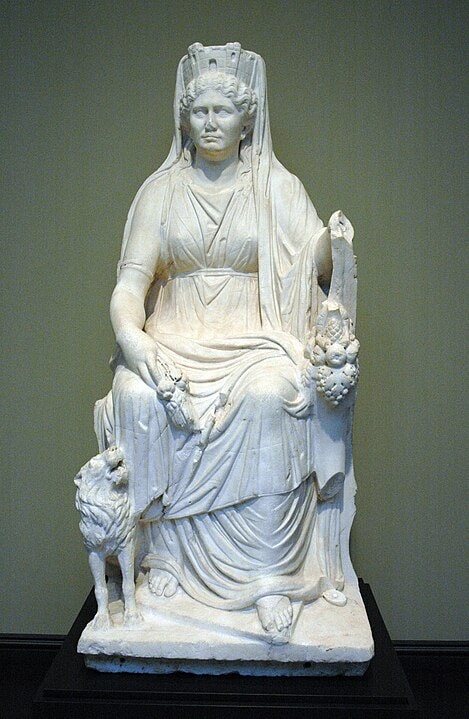
In ancient Greece, Cybele, also known as Kybele, was referred to as the Mountain Mother and the Earth Mother. She was the Greco-Roman nature goddess and the embodiment of the fertile Earth, most commonly associated with mountains, fortresses, caverns, and wildlife and animals, particularly bees and lions. The ancient Greeks and Romans commonly identified her with Rhea.
In Roman literature, her full name was Mater Deum Magna Idaea, which means Great Idaean Mother of the Gods. The Great Mother cult was widely worshiped in the area of Phrygia, in Asia Minor or today’s central Turkey. From there, her cult spread to Greece first, and later in 204 BC, after Hannibal invaded Italy, her worship spread to Rome as well.
In the ancient Orient, Greece, and Rome, Cybele was prominent as the Great Mother of gods, humans, and beasts. Her priests, called the Galli, ritually castrated themselves upon entering her service and assumed female identities and clothes. This was due to the myth of Cybele’s lover, the god of fertility Attis, who emasculated himself and bled to death under a pine tree. During the annual festival in Cybele’s honor, it was customary to cut a pine tree and bring it to her shrine.
9- Demeter
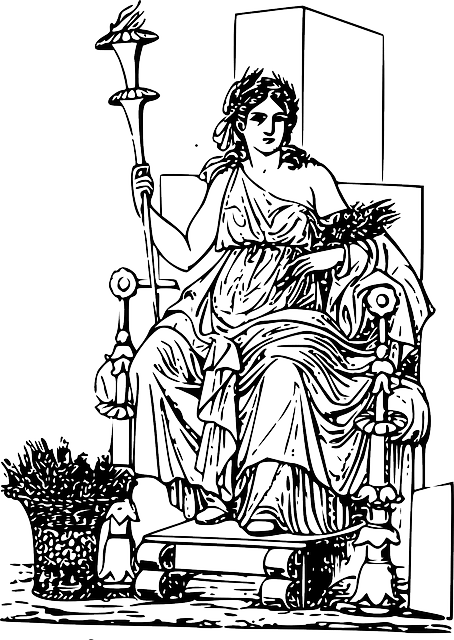
Demeter was a prominent nature deity in ancient Greece. She was worshiped as the goddess of the harvest, changing of the seasons, grains, crops, and the Earth’s fertility. She was also known as the Giver of Food or Grain. Because her name stems from the words de, meaning Earth, and meter, meaning Mother, she was often called the Earth’s Mother.
Together with her daughter, Persephone, she was the central deity in the Eleusinian Mysteries, which preceded the Olympian pantheon. According to the ancient Greeks, Demeter’s greatest gifts to Earth was grain, the cultivation of which made humans different from animals. Her most prominent symbol is the poppy plants, which were commonly made as offerings to the dead in Roman and Greek myths.
10- Diana
In Roman mythology, Diana, which means divine or heavenly, was the nature goddess, most commonly associated with the hunt, wild animals, woodlands, as well as the moon. She’s the parallel of the Greek goddess Artemis. She’s known as the virgin goddess who swore never to marry, together with the other two maiden goddesses, Vesta and Minerva. Diana was the patroness of women, virgins, and chastity.
According to the myth, Diana was Jupiter’s daughter, the god of sky and thunder, and Latona, the Titan goddess of motherhood and kindness. Apollo was her twin brother, and they were born on the island of Delos. Diana was widely worshiped as one aspect of the Roman triad, together with Egeria, the nymph goddess of water, and Diana’s servant, and Virbius, the god of woodlands.
11- Flora
In ancient Rome, Flora was the nature goddess of flowers, spring, and fertility. Her sacred symbol was the mayflower. Her name stems from the Latin word flos, meaning flower. In the contemporary English language, flora is the common noun for plants of a specific region.
As the fertility goddess, Flora was a particularly important deity worshiped during springtime. She was also considered the patroness of youth. Floralia was the six-day festival held in her honor, every year from the end of April until the beginning of May.
The festival represented the cycle of life, renewal, nature, and transformation. During the festival, the men would dress in flowers and women would dress as men. In the first five days, various memes and farces were performed, and there was a lot of nudity. On the sixth day, people would go hunting for hares and goats.
12- Gaia
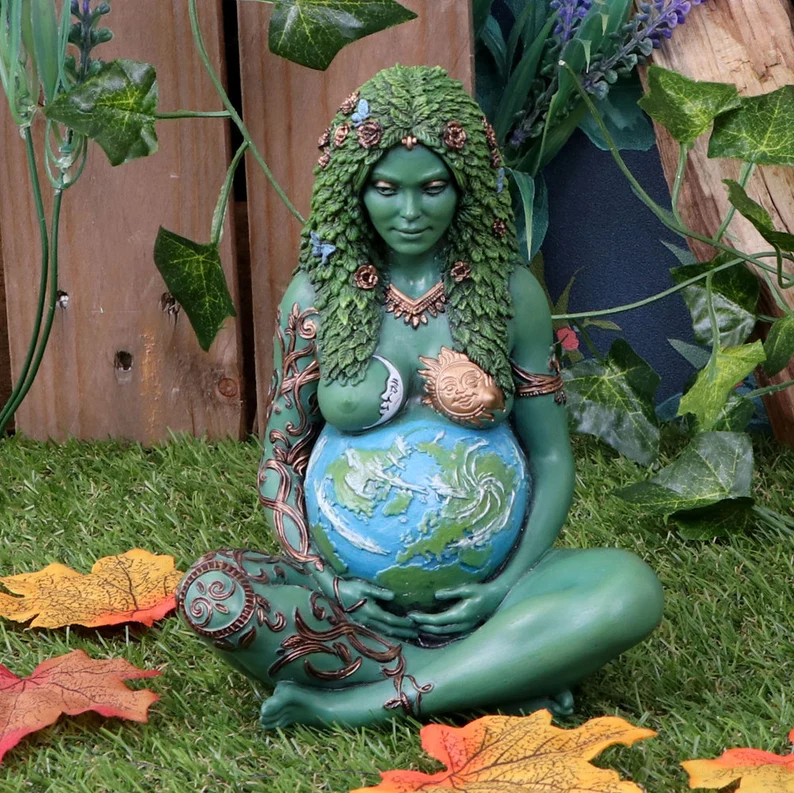
In the ancient Greek pantheon, Gaia was a primordial deity, also called Mother Titan or Great Titan. She was considered a personification of the Earth itself, and therefore also referred to as Mother Nature or Earth Mother.
According to Greek mythology, Gaia, Chaos, and Eros were the first entities to emerge from the Cosmic Egg, and the first beings that lived from the beginning of time. According to another creation myth, Gaia emerged after Chaos, and gave birth to Uranus, the personification of the sky, who she then took as her consort. Then, by herself, she gave birth to the mountains, called Ourea, and to the seas, called Pontus.
There are various depictions of Gaia in ancient art. Some depictions portray her as the goddess of fertility, and as a maternal, and full-bosomed woman. Others emphasize her association with nature, seasons, and agriculture, showing her wearing green clothes and accompanied by vegetation and fruits.
13- Konohanasakuya-hime
In Japanese mythology, Konohanasakuya-hime, also known as Kono-hana, was the goddess of blossom and delicate earthly life. Her sacred symbol was the cherry blossom. The goddess was the daughter of Ohoyamatsumi, or Oho-yama, the mountain god, and was considered the goddess of mountains and volcanoes herself as well as the personification of Mount Fuji.
According to the legend, Oho-yama had two daughters, the younger Kono-hama, the blossom-princess, and the older Iwa-Naga, the rock-princess. Oho-yama offered the hand of his older daughter to the god Ninigi, but the god was in love with the younger daughter and married her instead. Because he refused the rock-princess, and rather took the hand of the blossom-princess, Konohanasakuya-hime, human life was condemned to be short and fleeting, just like blossoms, instead of long-lasting and enduring, like rocks.
14- Naiades
In Greek mythology, Naiades, or Naiads, were the nymph goddesses of freshwaters, such as rivers, lakes, streams, marshes, and fountains. The five types of the Naiad nymphs included: Pegaiai (the spring nymphs); Krenaiai (fountains); Potameides (rivers and streams); Limnades (lakes); and Heleionomai (wetlands and marshes). They were usually portrayed as beautiful young women, sitting, standing, or lying beside a water body and holding hydria, a water pot, or a frond of a leafy plant.
It was believed that these nymphs, together with the goddess Artemis, were protectors and patroness of young girls and women, overlooking their safe passage from childhood to adulthood. Of the five nymph types, the nymphs of springs and fountains were the most distinguished and worshiped. Some even had shrines and cults dedicated to them. For example, the Anigrides of Elis nymphs, who were believed to cure diseases with their waters, as well as the Naiades of Mount Helikon, who were thought to possess prophetic and poetic inspiration in their springs had their own centers of worship.
15- Pachamama
In Inca mythology, Pachamama was the goddess of fertility, presiding over harvesting and planting. She was also known as Mother Earth and Mother World, because pacha means land or world, and mama means mother in Aymara language.
According to some myths, she was married to Pacha Kamaq, the World’s Creator, or sometimes, to Inti, the sun god, and the patron of the Inca empire. She was thought to cause earthquakes, and llamas were sacrificed to appease her. After the Spanish occupied their lands and brought Christianity, many indigenous people identified the Virgin Mary with Pachamama.
At meetings and different festivities, it’s still customary to toast to the honor of the Good Mother or Pachamama, by spilling a little bit of drink or chicha on the floor before starting to drink it. This toast, called challa, is performed almost daily. Martes de Challa or Challa’s Tuesday is a special day or holiday in Pachamama’s honor, when people throw candy, bury food, and burn incense.
16- Rhea
In ancient Greek religion, Rhea was a pre-Hellenic deity associated with nature, fruitfulness, and motherhood. Her name can be translated as flow or ease. She was worshiped as the Great Mother and the protector of everything that flows, including milk, birth waters, and blood. She was also considered the goddess of peace, ease, and comfort.
She’s very similar to Gaia, the Earth goddess, as well as Cybele, the Mother of Earth and all the gods. According to Greek mythology, she was the Titan daughter of Uranus, god of Heaven, and Gaia. Rhea was married to her brother Cronus, who swallowed all of their children, except Zeus. Rhea hid their youngest child, Zeus, in a cave on the island of Crete, saving him from his father.
17- Terra
Also known as Terra Mater, Tellus Mater, or Mother Earth, Terra was the nature goddess and the personification of the Earth in ancient Roman mythology. In ancient Rome, the goddess was commonly associated with Ceres, especially during different rituals honoring the Earth as well as agricultural fertility.
In January, both Terra and Ceres were honored as mothers of seeds and crops during the sowing festival called the Moveable Feast of Sementivae. In December, her temple, which was called the Temple of Tellus, had its anniversary. There was another festival in her honor around this time, called the Banquet for Tellus and Ceres, celebrating the Earth’s productivity and its growing power.
18- Xochiquetzal
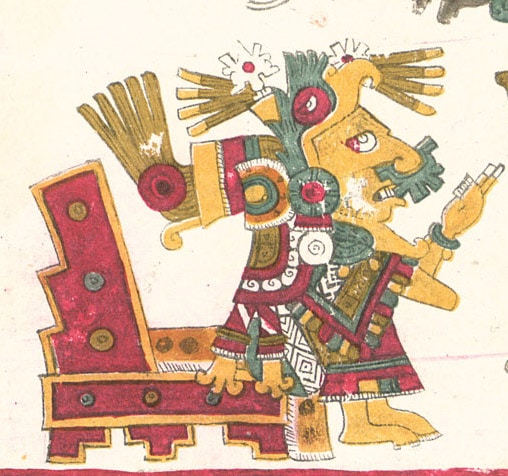
Xochiquetzal, also called Ichpōchtli, meaning flower and feather, is an Aztec goddess associated with nature, agriculture, fertility, female sexual power, and beauty. In Aztec mythology, she was worshiped as the patroness and protector of young mothers, pregnancy, childbirth, and all the crafts and work practiced by women, including embroidery and weaving.
Xochiquetzal was usually depicted as a young and alluring woman, richly dressed in flowers, especially marigolds, symbolizing vegetation. An entourage of butterflies and birds always followed the goddess. Her followers would wear animal masks with flower motifs at the festival that was held every eight years in her honor.
To Wrap Up
As we can see from the list above, the majority of the goddesses associated with nature are linked to the Earth and to fertility. This is especially true for deities in Roman and Greek mythologies. As mythologies reflect the human needs and concerns during ancient times, we can conclude that our ancestors were particularly concerned with reproduction and fertility of both people and the Earth. The list of the most prominent nature goddesses proves this recurring theme, as they are all in some way connected to Mother Earth and represent motherhood, fertility, as well as natural objects and phenomena.








